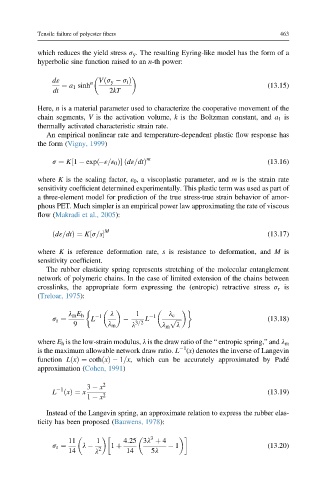Page 490 - Handbook of Properties of Textile and Technical Fibres
P. 490
Tensile failure of polyester fibers 463
which reduces the yield stress s y . The resulting Eyring-like model has the form of a
hyperbolic sine function raised to an n-th power:
dε n Vðs y s i Þ
¼ a 1 sinh (13.15)
dt 2kT
Here, n is a material parameter used to characterize the cooperative movement of the
chain segments, V is the activation volume, k is the Boltzman constant, and a 1 is
thermally activated characteristic strain rate.
An empirical nonlinear rate and temperature-dependent plastic flow response has
the form (Vigny, 1999)
m
s ¼ K½1 expð ε=ε 0 Þ ðdε=dtÞ (13.16)
where K is the scaling factor, ε 0 , a viscoplastic parameter, and m is the strain rate
sensitivity coefficient determined experimentally. This plastic term was used as part of
a three-element model for prediction of the true stress-true strain behavior of amor-
phous PET. Much simpler is an empirical power law approximating the rate of viscous
flow (Makradi et al., 2005):
M
ðdε=dtÞ¼ K½s=s (13.17)
where K is reference deformation rate, s is resistance to deformation, and M is
sensitivity coefficient.
The rubber elasticity spring represents stretching of the molecular entanglement
network of polymeric chains. In the case of limited extension of the chains between
crosslinks, the appropriate form expressing the (entropic) retractive stress s r is
(Treloar, 1975):
l m E h 1 l 1 1 l c
s r ¼ L L p ffiffiffiffi (13.18)
9 l m l 3=2 l m l
where E h is the low-strain modulus, l is the draw ratio of the “ entropic spring,” and l m
1
is the maximum allowable network draw ratio. L (x) denotes the inverse of Langevin
function LðxÞ¼ cothðxÞ 1=x, which can be accurately approximated by Padé
approximation (Cohen, 1991)
3 x 2
1
L ðxÞ¼ x (13.19)
1 x 2
Instead of the Langevin spring, an approximate relation to express the rubber elas-
ticity has been proposed (Bauwens, 1978):
3
11 1 4:25 3l þ 4
s r ¼ l 1 þ 1 (13.20)
14 l 2 14 5l

